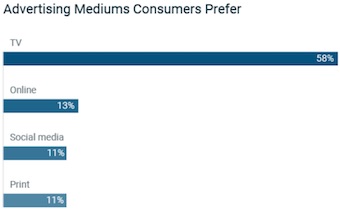TV advertisements retain a unique value for brands’ ability to connect with consumers, as most consumers view TV advertisements as memorable and effective, and prefer them over ads seen via different mediums, according to a new survey of consumer advertising preferences conducted by Washington, D.C.-based research and consulting firm Clutch.
More than half of respondents polled in the Clutch survey (58 percent) said they prefer TV advertisements over any other medium, followed by online ads (13 percent), and ads that appear over social media sites and in print (both 11 percent).
A majority of consumers polled (65 percent) said they were able to recall TV advertisements more than any other medium. Most (53 percent) said they prefer advertisements that are humorous. A similar number (51 percent) said they enjoy ads from brands that appeal to them, followed by a new product that speaks to their interest (46 percent) and a product that’s relatable (44 percent).
Consumers said the primary reason they dislike advertisements is because they didn’t learn anything about the product (51 percent) or that the advertisement in question wasn’t relatable (48 percent) or was unappealing (46 percent).
When it comes to digital advertising, by contrast, the survey found Facebook is the most favored platform, preferred by 36 percent. This is followed by banner ads (21 percent), video/interactive (19 percent) and Google search (9 percent). The survey also discovered that very few consumers like retargeted advertisements (two percent), or ads that use cookie-based technology to reach audiences based on sites they've recently visited.
Males are more likely to enjoy ads featuring technology or sports products (both 49 percent), while women are more likely to enjoy ads involving fashion and beauty (69 percent) and travel and leisure (54 percent). Both sexes (88 percent women and 70 percent men) agree that food and drink are the preferred advertising category.
Clutch’s “What Consumers Want in Advertising” survey polled more than 1,000 U.S. consumers in November who reported seeing or hearing an advertisement in the past week.



 Abandon traditional content plans focused on a linear buyer progression and instead embrace a consumer journey where no matter which direction they travel, they get what they need, stressed marketing pro Ashley Faus during O'Dwyer's webinar Apr. 2.
Abandon traditional content plans focused on a linear buyer progression and instead embrace a consumer journey where no matter which direction they travel, they get what they need, stressed marketing pro Ashley Faus during O'Dwyer's webinar Apr. 2. Freelance marketers and the companies that hire them are both satisfied with the current work arrangements they have and anticipate the volume of freelance opportunities to increase in the future, according to new data on the growing freelance marketing economy.
Freelance marketers and the companies that hire them are both satisfied with the current work arrangements they have and anticipate the volume of freelance opportunities to increase in the future, according to new data on the growing freelance marketing economy. Home Depot's new attempt to occupy two market positions at once will require careful positioning strategy and execution to make it work.
Home Depot's new attempt to occupy two market positions at once will require careful positioning strategy and execution to make it work. Verizon snags Peloton Interactive chief marketing officer Leslie Berland as its new CMO, effective Jan. 9. Berland succeeds Diego Scotti, who left Verizon earlier this year.
Verizon snags Peloton Interactive chief marketing officer Leslie Berland as its new CMO, effective Jan. 9. Berland succeeds Diego Scotti, who left Verizon earlier this year.  Norm de Greve, who has been CMO at CVS Health since 2015, is taking the top marketing job at General Motors, effective July 31.
Norm de Greve, who has been CMO at CVS Health since 2015, is taking the top marketing job at General Motors, effective July 31.


 Have a comment? Send it to
Have a comment? Send it to 
No comments have been submitted for this story yet.